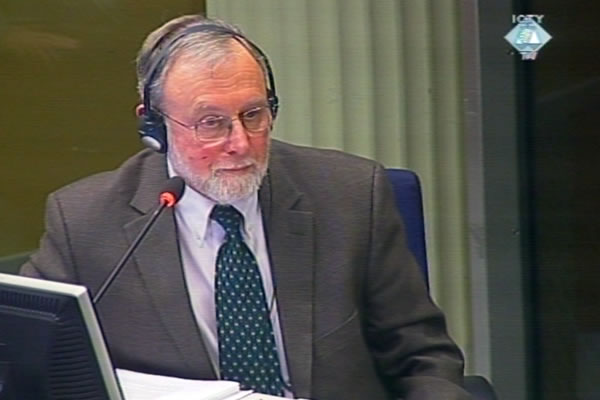Home
KARADZIC: MASS GRAVES WERE THE RESULT OF TERRAIN CLEAR-UP
In the cross-examination of forensic anthropologist William Haglund, Karadzic tried to prove that most of the victims from the Srebrenica mass graves had died in combat. ‘People do not fight blindfolded’, responded the witness. Haglund dismissed Karadzic’s suggestion that the blindfolds were ribbons that warriors wore around their heads that ‘accidentally slipped over the victims’ eyes’ as the bodies decomposed
 William Haglund, witness at the Radovan Karadzic trial
William Haglund, witness at the Radovan Karadzic trial In the cross-examination of forensic anthropologist William Haglund, the accused Radovan Karadzic presented his version of the events in Srebrenica. Referring to the evidence of Dutch colonel Franken, Karadzic said that the column of 13,000 to 15,000 men – a third of whom were armed – ‘fought on as they tried to break through’ towards Tuzla. According to the BH Army data, ’10,000 fighters’ arrived there while about 3,000 men had been ‘lost in the woods’: they were killed fighting the Serb forces.
To complete this picture, Karadzic trotted out another well-known argument: the war in BH went on for 44 months and there was heavy fighting in the Podrinje area, with a lot of casualties. Karadzic also said that warring factions handed the bodies of their soldiers killed in action to the soldiers’ families, and buried the dead enemy soldiers in mass graves ‘in line with the law on the hygiene and sanitation measures’. Karadzic put it to the witness that 85 % of BH Army soldiers didn’t wear military uniforms.
The American anthropologist noted that the victims buried in the mass graves at the Branjevo farm and near Orahovac, where he was involved in the exhumations, were blindfolded, often with their hands tied behind their backs. ‘People don’t fight with blindfolds on’, Dr Haglund remarked. Karadzic then put it to the witness that these were in fact ‘warriors’ ribbons’ worn around the heads that had slipped down as the bodies decomposed. The witness replied that it was ‘hard to imagine that all the warriors’ ribbons had slipped from the foreheads to the eyes and remained there, tightly bound’.
Dr Haglund agreed with Karadzic that when the mass grave exhumations began he couldn’t make any claims about the victims’ identity with any degree of certainty. ‘Although it is easy to get an idea about that as soon as you start finding links between the people buried in the graves and the lists of missing persons from Srebrenica in July 1995’, the witness added. Dr Haglund dismissed the suggestion made by the accused that if the bodies in a mass grave show varying degrees of decomposition this is an indication that more bodies were added to the graves at later times. The witness is convinced that no new bodies were buried in such graves at a later time; in fact, some bodies had been removed from them and reburied in secondary graves.
After Dr Haglund completed his evidence, Jean-Rene Ruez returned to the witness stand as the hearing was drawing to a close. Karadzic will continue his cross-examination of the French police inspector and former head of the OTP’s Srebrenica Investigation tomorrow.
Linked Reports
- Case : Karadzic
- 2012-01-30 BADLY ELIMINATED TRACES OF CRIME
- 2012-01-27 RECONSTRUCTING THE CRIMES IN SREBRENICA
- 2012-01-27 KARADZIC WANTS INTERVIEWS WITH GREEK PRESIDENT AND FRENCH OFFICER
- 2012-02-01 RUEZ: ONLY ‘VICTIMS OF EXTERMINATION’ WERE BURIED IN MASS GRAVES
- 2012-02-02 KARADZIC COUNTS PRISONERS ON AERIAL PHOTOS
- 2012-02-07 LOGISTICS OFFICER FROM 10TH SABOTAGE DETACHMENT TESTIFIES AT KARADZIC TRIAL
